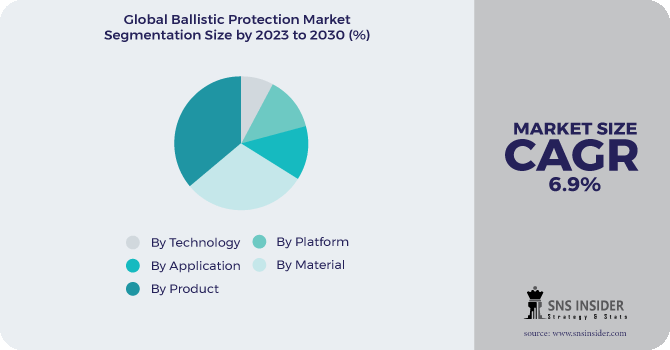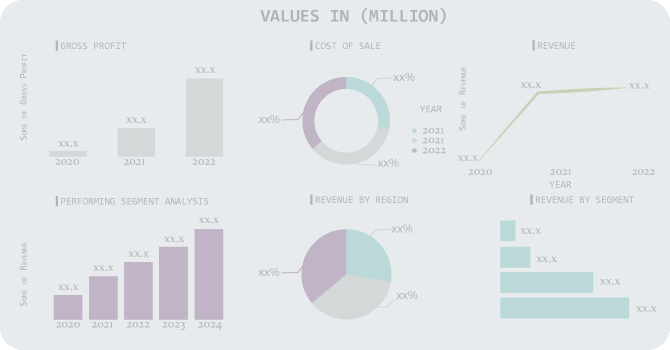Ballistic Protection Market Report Scope & Overview:
The Ballistic Protection Market Size was valued at USD 14.74 billion in 2022 and is expected to reach USD 25.13 billion by 2030, with a growing CAGR of 6.9% over the forecast period 2023-2030.
Ballistic protection shields the body and eyes against diverse shapes, sizes, and impact velocities of missiles, bullets, projectiles, and mortars. It is primarily used to defend troops, police officers, and other security personnel. Historically, ballistic protection devices were constructed of metals and were too heavy to wear; however, they now give the same amount of ballistic protection while being relatively light in weight and hence comfortable to wear. Ceramic, carbon fibre composites, aramid, Lexan, and glass are used to make it.
.png)
To get more information on Ballistic Protection Market - Request Free Sample Report
The Ballistic Protection Market is predicted to develop significantly because to increased demand for defence equipment as global conflicts intensify. It provides protection against bullets, splinter grenades, pellets, ballistic missiles, and mines. Ballistic protection is used in boiler armour to prevent tank body fragmentation from a missile or anti-tank gun attack, and it includes personal protection items such as ballistic helmets and bulletproof vests to guard against bullets.
MARKET DYNAMICS
KEY DRIVERS
-
Materials that are lightweight, comfortable, and strong are required.
-
Rising geopolitical tensions in emerging markets
RESTRAINTS
-
Strict requirements for ballistic composite products
-
Failure to give complete security
OPPORTUNITIES
-
Asia Pacific demand is rapidly expanding.
-
Composite armour material advancements.
CHALLENGES
-
Lightweight armour and ballistic composite materials are expensive.
-
Increased comfort and functionality are in high demand.
IMPACT OF COVID-19
Due to the government-imposed lockdown to slow the spread of COVID-19, ballistic equipment manufacturers are obliged to shut down production operations.
Due to supply chain disruption induced by government measures to limit the COVID-19 epidemic, military agencies are compelled to postpone ballistic protective equipment purchase.
The research and development of ballistic shielding materials is being hampered by a shortage of international personnel as a result of the government-mandated travel prohibition enforced in the aftermath of the COVID-19 epidemic.
Installation and upgrade of ballistic protection equipment in military and commercial vehicles will be delayed due to manufacturer delays in procuring ballistic protection equipment.
The airborne category is expected to increase at a faster CAGR throughout the projection period. It encompasses fixed-wing and helicopter aircraft, as well as unmanned aerial vehicles. There is an increasing demand for military aircraft across all aviation platforms. This demand is due to increased military expenditures in a number of countries, including China, Japan, South Korea, and the United States. The UAV segment is predicted to grow at the fastest rate during the projection period, 2021-2028. The expansion of the airborne category is mostly linked to changes in conflict dynamics, which led to the introduction of UAVs on the battlefield.
During the forecast period, the homeland security segment is expected to grow faster than the military segment. Homeland security officers in the field wear ballistic-resistant body armour to protect themselves from specific ballistic threats. Personal protective equipment, such as body vests, ballistic helmets, and gloves, is used by Homeland Security officers to ensure their safety during any mission. Ballistic helmets are designed to protect the wearer from small weapons fire and fragmentation. Homeland security personnel' fighting systems are ballistic resistant due to the usage of ceramics and thermoplastics.
Armor that is soft Soft armour dominated the global market in 2021 due to benefits such as high shear strength, light weight, and high flexibility, which are likely to drive the segment's expansion.
Armor of Hardness During the forecast period, the segment is expected to grow at a faster rate. Soft armour is thinner and more flexible than hard armour. Hard armour is made from polymer composites strengthened with steel and ceramics.
The glass fibre Increasing government laws governing the safety of passengers, crew, and officers are likely to promote the segment's growth. Increased government initiatives to supply secure barriers such as bulletproof glass, vests, automobiles, and buses to soldiers and officers to avert casualties are likely to drive the segment's expansion.
Composites Composites provide advantages such as corrosion resistance and fatigue resistance. Furthermore, the increasing use of composites in the manufacturing of aircraft components is likely to fuel the expansion of this segment. As a result, the category led the market during the forecast period and is likely to grow at the fastest CAGR between 2021 and 2028.
Ceramic The hard armour is constructed of polymer composites reinforced with ceramic.
Fabric The rising use of fabric in the production of lightweight ballistic garments is likely to fuel the segment's growth.
Metals and alloys: Increasing military modernization plans are likely to promote market growth.
KEY MARKET SEGMENTATION
By Material
-
Bulletproof Glass
-
Composites
-
Ceramics
-
Lexan
-
Metals & Alloys
-
Fabric
-
Others
By Application
-
Military
-
Commercial
By Platform
-
Airborne
-
Marine
-
Land
By Technology
-
Soft Armor
-
Hard Armor
By Product
-
Personal Protection Equipment
-
Cockpit Ballistic Protection
-
Ballistic Door
-
Ballistic Floors
-
Engine Protection
-
Hull & Body
-
Weapon Station & Optronics
-
Others

Need any customization research on Ballistic Protection Market - Enquiry Now
REGIONAL ANALYSIS
From 2022 to 2030, the Asia Pacific ballistic protection market is expected to develop at the fastest CAGR. Due to economic growth and increased defence spending in countries such as India, China, Japan, South Korea, and Australia, Asia Pacific is an expanding market for ballistic protection systems. These countries' governments and local companies are also partnering with the contractors and assisting them with the procurement process by providing required financial and infrastructure assistance. The growing number of insurgent organisations infiltrating regions and employing lethal explosives such as IEDs and bombs has increased the demand for ballistic defence systems.
REGIONAL COVERAGE:
-
North America
-
USA
-
Canada
-
Mexico
-
-
Europe
-
Germany
-
UK
-
France
-
Italy
-
Spain
-
The Netherlands
-
Rest of Europe
-
-
Asia-Pacific
-
Japan
-
south Korea
-
China
-
India
-
Australia
-
Rest of Asia-Pacific
-
-
The Middle East & Africa
-
Israel
-
UAE
-
South Africa
-
Rest of Middle East & Africa
-
-
Latin America
-
Brazil
-
Argentina
-
Rest of Latin America
-
KEY PLAYERS
The Major Players are 3M, Permali, Rheinmetall AG., Saab AB, Craig International Ballistics Pty Ltd, BAE Systems, Revision Military, MKU Limited, Survitec Group Limited, Point Blank Enterprises, and other players
3M-Company Financial Analysis

| Report Attributes | Details |
|---|---|
| Market Size in 2022 | US$ 14.74 Billion |
| Market Size by 2030 | US$ 25.13 Billion |
| CAGR | CAGR of 6.9% From 2023 to 2030 |
| Base Year | 2022 |
| Forecast Period | 2023-2030 |
| Historical Data | 2020-2021 |
| Report Scope & Coverage | Market Size, Segments Analysis, Competitive Landscape, Regional Analysis, DROC & SWOT Analysis, Forecast Outlook |
| Key Segments | • By Material (Bulletproof Glass, Composites, Ceramics, Lexan, Metals & Alloys, Fabric and Others) • By Application (Homeland Security, Military and Commercial) • By Platform (Airborne, Marine and Land) • By Technology (Soft Armor and Hard Armor) • By Product (Personal Protection Equipment, Cockpit Ballistic Protection, Ballistic Door, Ballistic Floors, Engine Protection, Hull & Body, Weapon Station & Optronics and Others) |
| Regional Analysis/Coverage | North America (USA, Canada, Mexico), Europe (Germany, UK, France, Italy, Spain, Netherlands, Rest of Europe), Asia-Pacific (Japan, South Korea, China, India, Australia, Rest of Asia-Pacific), The Middle East & Africa (Israel, UAE, South Africa, Rest of Middle East & Africa), Latin America (Brazil, Argentina, Rest of Latin America) |
| Company Profiles | 3M, Permali, Rheinmetall AG., Saab AB, Craig International Ballistics Pty Ltd, BAE Systems, Revision Military, MKU Limited, Survitec Group Limited, Point Blank Enterprises, and other players. |
| DRIVERS | • Materials that are lightweight, comfortable, and strong are required. • Rising geopolitical tensions in emerging markets |
| RESTRAINTS | • Strict requirements for ballistic composite products • Failure to give complete security |

